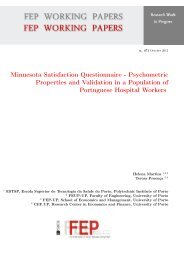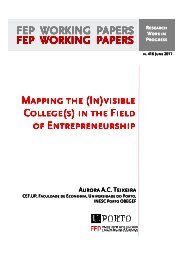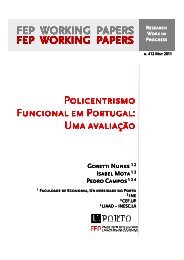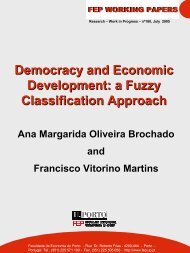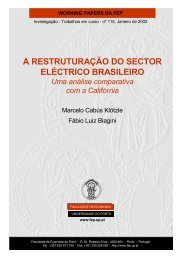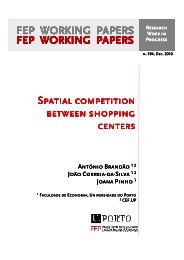Ant Colony Optimization: a literature survey - FEP - Working Papers
Ant Colony Optimization: a literature survey - FEP - Working Papers
Ant Colony Optimization: a literature survey - FEP - Working Papers
Create successful ePaper yourself
Turn your PDF publications into a flip-book with our unique Google optimized e-Paper software.
identified.Baykasoglu et al (2006) solve a dynamic facility layout problem, where each ant has to decide,for each period t, the location of the n departments considered. The authors use a stringwith size t × n to represent the final solution, where the first n consecutive values identify thedepartment locations for the first period, the second n consecutive values give the locationsfor the second period, and so on. Therefore, to construct a solution, all an ant has to do is tochoose t × n elements of the type department location, accordingly to the pheromone levels,and provided that, within a time period, no department location is repeated, thus guaranteeingthe construction of a feasible solution.Partitioning and covering problems are solved with ACO algorithms by Crawford and Castro(2006). In this case, given a set of columns and rows, the objective is to choose a subset ofcolumns covering all rows while minimizing cover costs. The solution is represented by asubset of columns. This implies a different approach, from the ones we have been mentioningbefore, because the solution components are represented by nodes and not by arcs, a fact thatsimplifies the calculations. The construction is straightforward. Each ant starts with an emptyset of columns. Then, the ant adds columns one at the time, based on pheromone values, untilall rows are covered. Solutions constructed in this way, can be unfeasible in the partitioningcase because a row may be covered by more than one column. That is why post processingprocedures, that will try to eliminate redundant columns, are added afterwards in order to turnunfeasible solutions into feasible ones.In a transportation problem with N supply nodes and M demand nodes, it is known that asolution has, at most, N + M − 1 arcs. This observation allows Altiparmak and Karaoglan(2006) to decide on allowing each ant in their algorithm to be able to choose N + M − 1 arcsto construct a feasible solution. Each ant starts by randomly choosing an arc from the set ofavailable arcs A, and proceeds the construction by adding, one at the time, the remaining arcsby using pheromone information. The arcs in the set of allowed arcs to be chosen to enterthe solution is defined by the demand and supply nodes that have not exceeded already theirdemand and supply, respectively. In this case the sense of path is not applied since arcs arechosen arbitrarily as long as they satisfy demand and supply constraints.The Single Source Capacitated Facility Location Problem deals with the location of a set offacilities, with a limited capacity on the supply, and the allocation of a single facility to eachcustomer so as to satisfy customer demands and minimize total costs. Chen and Ting (2008)propose an algorithm to solve it which integrates an <strong>Ant</strong> <strong>Colony</strong> System with two types of ants,location ants and assignment ants. Therefore, there are two different solution representationsand constructions. Location ants select the facilities to be opened, and their solutions are notuniform, in the sense that each ant can open a different number of facilities, according to:9



